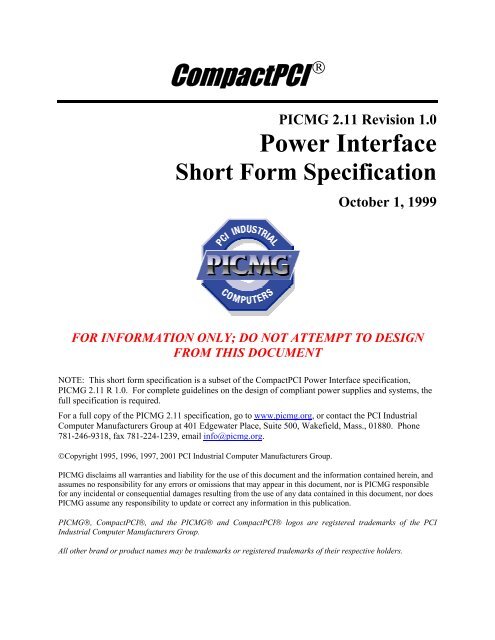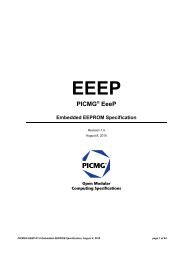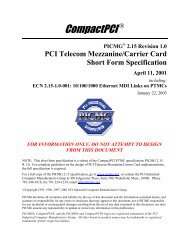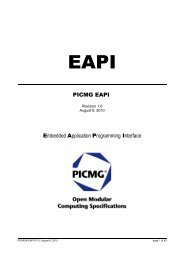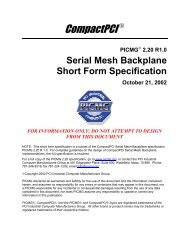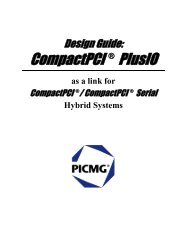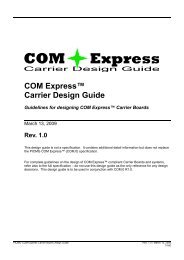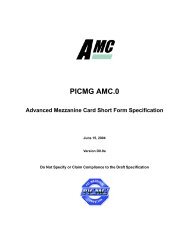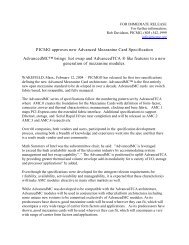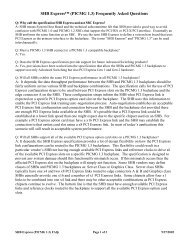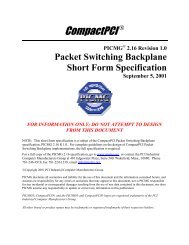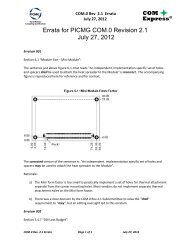PICMG 2.11, CompactPCI Power Interface
PICMG 2.11, CompactPCI Power Interface
PICMG 2.11, CompactPCI Power Interface
You also want an ePaper? Increase the reach of your titles
YUMPU automatically turns print PDFs into web optimized ePapers that Google loves.
<strong>CompactPCI</strong> ®<br />
<strong>PICMG</strong> <strong>2.11</strong> Revision 1.0<br />
<strong>Power</strong> <strong>Interface</strong><br />
Short Form Specification<br />
October 1, 1999<br />
FOR INFORMATION ONLY; DO NOT ATTEMPT TO DESIGN<br />
FROM THIS DOCUMENT<br />
NOTE: This short form specification is a subset of the <strong>CompactPCI</strong> <strong>Power</strong> <strong>Interface</strong> specification,<br />
<strong>PICMG</strong> <strong>2.11</strong> R 1.0. For complete guidelines on the design of compliant power supplies and systems, the<br />
full specification is required.<br />
For a full copy of the <strong>PICMG</strong> <strong>2.11</strong> specification, go to www.picmg.org, or contact the PCI Industrial<br />
Computer Manufacturers Group at 401 Edgewater Place, Suite 500, Wakefield, Mass., 01880. Phone<br />
781-246-9318, fax 781-224-1239, email info@picmg.org.<br />
©Copyright 1995, 1996, 1997, 2001 PCI Industrial Computer Manufacturers Group.<br />
<strong>PICMG</strong> disclaims all warranties and liability for the use of this document and the information contained herein, and<br />
assumes no responsibility for any errors or omissions that may appear in this document, nor is <strong>PICMG</strong> responsible<br />
for any incidental or consequential damages resulting from the use of any data contained in this document, nor does<br />
<strong>PICMG</strong> assume any responsibility to update or correct any information in this publication.<br />
<strong>PICMG</strong>®, <strong>CompactPCI</strong>®, and the <strong>PICMG</strong>® and <strong>CompactPCI</strong>® logos are registered trademarks of the PCI<br />
Industrial Computer Manufacturers Group.<br />
All other brand or product names may be trademarks or registered trademarks of their respective holders.
Overview<br />
This short form specification is a subset of the full <strong>CompactPCI</strong> <strong>Power</strong> <strong>Interface</strong><br />
Specification, <strong>PICMG</strong> <strong>2.11</strong> Revision 1.0. This document is meant as a guide for those<br />
considering use of pluggable style power supplies for <strong>CompactPCI</strong>, but is not a design<br />
document. Anyone wishing to design a power supply backplane for <strong>CompactPCI</strong> power<br />
supplies should obtain the full specification from <strong>PICMG</strong>. You can also download an<br />
electronic version of this short form specification from the <strong>PICMG</strong> Web site at<br />
www.picmg.org. The <strong>CompactPCI</strong> specifications are open specifications supported by<br />
the <strong>PICMG</strong> (PCI Industrial Computer Manufacturers Group), which is a consortium of<br />
companies involved in utilizing PCI for embedded applications. <strong>PICMG</strong> controls this<br />
specification.<br />
The complete <strong>PICMG</strong> <strong>2.11</strong> specification defines the electrical and mechanical interfaces,<br />
and minimum requirements for modular <strong>CompactPCI</strong> pluggable power supplies and<br />
related <strong>CompactPCI</strong> platforms based on the <strong>CompactPCI</strong> core specification, <strong>PICMG</strong> 2.0<br />
R2.1. The full specification, <strong>PICMG</strong> <strong>2.11</strong>, provides a defined interface to support higher<br />
power supply output current levels and 6U form factor power supplies, as well as<br />
providing some additional functionality to support Hot Swap applications, and a growth<br />
path for high availability systems.<br />
Scope<br />
The scope of this specification covers 3U and 6U IEEE 1101.x compatible modular<br />
pluggable power supply modules and platforms that support pluggable power supply<br />
modules.<br />
This specification is intended to cover modular pluggable power supplies in the power<br />
range of 100 W to 600 W.<br />
Desired Audience<br />
<strong>CompactPCI</strong> exists to provide a standard form factor for those applications requiring the<br />
high performance of PCI as well as the small size and ruggedness of a rack mount<br />
system. <strong>CompactPCI</strong> provides a mechanism for OEM and end users to directly apply<br />
PCI components and technology to a new mechanical form factor while maintaining<br />
compatibility with existing operating systems and application software available for<br />
desktop PCI.<br />
Pluggable power supplies exist to provide a reliable, convenient mechanism for power<br />
supply servicing via front panel access. This is particularly useful for hot swap systems<br />
and high availability systems with dual redundant or N+1 redundant power supplies.<br />
FOR INFORMATION ONLY;<br />
DO NOT ATTEMPT TO DESIGN FROM THIS DOCUMENT
Electrical<br />
<strong>Power</strong> Supply<br />
<strong>CompactPCI</strong> pluggable power supplies that conform to this specification shall conform to<br />
the following electrical requirements:<br />
a) shall provide all required outputs, per <strong>PICMG</strong> <strong>CompactPCI</strong> 2.0 R 3.0 core<br />
specification,<br />
b) shall support the power connector pinout described in the full <strong>PICMG</strong> <strong>2.11</strong><br />
specification (which includes information on required vs. optional signals),<br />
c) shall meet the voltage tolerance and ripple requirements of <strong>PICMG</strong> 2.0 when<br />
connected to a backplane meeting the capacitance recommended in <strong>PICMG</strong> 2.0 for a<br />
two slot configuration (twice the recommended single slot capacitance),<br />
d) may use two power connectors (P1 and P2) for higher output power supplies,<br />
e) The signals GA[2..0] on the power connector, are available for use by power supplies<br />
to provide a unique differentiation based upon which physical slot the board has been<br />
inserted.<br />
Backplane/Platform<br />
<strong>CompactPCI</strong> backplanes/platforms supporting pluggable power supplies that conform to<br />
this specification shall conform to the following electrical requirements:<br />
a) shall support the following control signals at the system slot:<br />
FAL# (Slot 1, J2:C15)<br />
DEG# (Slot 1, J2:C16)<br />
b) shall support the following control signals at the power supply slot:<br />
EN#<br />
INH#<br />
c) may use two power connectors (J1 and J2) for higher output power supplies<br />
d) The GA0, GA1, and GA2 signals shall be supported by the backplane as outlined in<br />
<strong>PICMG</strong> <strong>2.11</strong>.<br />
Mechanical<br />
Board<br />
<strong>CompactPCI</strong> pluggable power supplies that conform to this specification shall conform to<br />
the following mechanical requirements:<br />
a) shall meet mechanical envelope dimensions as depicted in the full <strong>PICMG</strong> <strong>2.11</strong>,<br />
b) shall meet the connector location dimensions as depicted in the full <strong>PICMG</strong> <strong>2.11</strong><br />
FOR INFORMATION ONLY;<br />
DO NOT ATTEMPT TO DESIGN FROM THIS DOCUMENT
This is accomplished by using VITA 30-compatible 1/2 HP offset guide rails for<br />
pluggable power supplies. Note that this means that the card guide’s slot and<br />
injector/ejector PCB mounting surface are shifted 2.54 mm (0.1 in.) to the right.<br />
c) power supplies should be 4HP width, or any multiple thereof; power supplies may be<br />
any other width that is greater than 4HP and is a multiple of 1HP, but this is not<br />
recommended because it may cause packaging integration problems,<br />
d) shall provide IEEE 1101.10 compatible front panel with EMI gasket and guide pin,<br />
e) should provide IEEE 1101.11 compatible front panel protective ground,<br />
f) 3U power supplies should provide an IEEE 1101.10 compatible injector/extractor<br />
device, located on the lower edge of the board’s front panel,<br />
g) 6U power supplies should provide two IEEE 1101.10 compatible injector/extractor<br />
devices,<br />
h) shall provide IEEE 1101.10 compatible front panel keying; and the IEEE 1101.10<br />
compatible front panel keying shall be set to the key code specified in <strong>PICMG</strong> <strong>2.11</strong><br />
according to the configuration of the power supply;<br />
i) power supply manufacturers should define their specific requirements such as<br />
maximum operating temperature and cooling, including required cooling airflow rate,<br />
and any restrictions on air flow direction. This cooling air flow rate is the air flow<br />
required to cool the power supply at maximum rated output power and maximum<br />
rated temperature, when tested within the power supply’s mechanical envelope (e.g.<br />
4HP, 8HP width of power supply), and should provide data on the resulting pressure<br />
drop at that required air flow rate.<br />
Backplane/Platform<br />
<strong>CompactPCI</strong> backplanes/platforms supporting pluggable power supplies that conform to<br />
this specification shall conform to the following mechanical requirements:<br />
a) shall meet the backplane/platform connector location dimensions as depicted in the<br />
full <strong>PICMG</strong> <strong>2.11</strong><br />
This shall be accomplished by using VITA 30-compatible 1/2 HP offset guide<br />
rails for pluggable power supplies. Color shall be green. Note that this means<br />
that the slot in the card guide and injector/ejector PCB mounting surface are<br />
shifted 2.54 mm (0.1 in.) to the right with respect to the front panel keying and<br />
alignment pin.<br />
b) should provide IEEE 1101.11 compatible front panel protective ground.<br />
c) shall provide IEEE1101.10 compatible front panel keying; and the IEEE1101.10<br />
compatible front panel keying shall be set to the key code specified in <strong>PICMG</strong> <strong>2.11</strong><br />
according to the configuration of the power supply that is supported by the platform.<br />
Front Panel Keying<br />
Refer to IEEE1101.10 for information on key locations. Use of front panel key chambers<br />
D, E, and F are defined for both 3U and 6U pluggable power supply slot locations only.<br />
FOR INFORMATION ONLY;<br />
DO NOT ATTEMPT TO DESIGN FROM THIS DOCUMENT
Front panel key chambers A, B, and C are also defined for 6U power supplies, and are set<br />
identically to key chambers D, E, and F. Chambers A, B, and C are keyed on 6U power<br />
supplies in order to provide keys physically close to both P1/J1 and P2/J2. Since power<br />
supplies are using a different type of connector vs. other <strong>CompactPCI</strong> slots, there is no<br />
possibility of mating problems with 2mm connectors. These key options will be<br />
independent of the 2mm application card keys, and may duplicate key codes that are used<br />
for different purposes elsewhere in the system. This is acceptable, and will cause no<br />
problems. See tables in the complete <strong>PICMG</strong> <strong>2.11</strong> specification for more information.<br />
FOR INFORMATION ONLY;<br />
DO NOT ATTEMPT TO DESIGN FROM THIS DOCUMENT
Cross Sectional Board, Connector, Backplane and Front Panel View<br />
FOR INFORMATION ONLY;<br />
DO NOT ATTEMPT TO DESIGN FROM THIS DOCUMENT
Modular <strong>Power</strong> Supply Connector<br />
Pin # (1) Staging # (2) Signal Name Description<br />
1-4 M V1 V1 Output<br />
5-12 M RTN V1 and V2 Return<br />
13-18 M V2 V2 Output<br />
19 M RTN V3 Return<br />
20 M V3 V3 Output<br />
21 M V4 V4 Output<br />
22 M RTN Signal Return<br />
23 M RESERVED Reserved<br />
24 M RTN V4 Return<br />
25 M GA0 Geographic Address Bit 0<br />
26 M RESERVED Reserved<br />
27 S EN# Enable<br />
28 M GA1 Geographic Address Bit 1<br />
29 M V1ADJ V1 Adjust<br />
30 M V1 SENSE V1 Remote Sense<br />
31 M GA2 Geographic Address Bit 2<br />
32 M V2ADJ V2 Adjust<br />
33 M V2 SENSE V2 Remote Sense<br />
34 M S RTN Sense Return<br />
35 M V1 SHARE V1 Current Share<br />
36 M V3 SENSE V3 Remote Sense<br />
37 M IPMB_SCL (3) Reserved for System Management Bus<br />
38 M DEG# Degrade Signal<br />
39 M INH# Inhibit<br />
40 M IPMB_SDA (3) Reserved for System Management Bus<br />
41 M V2 SHARE V2 Current Share<br />
42 M FAL# Fail Signal<br />
43 M IPMB_PWR (3) Reserved for System Management Bus<br />
44 M V3 SHARE V3 Current Share<br />
45 L CGND Chassis Ground (safety ground)<br />
46 M ACN/+DC IN AC Input – Neutral; +DC Input<br />
47 M ACL/-DC IN AC Input – Line; -DC Input<br />
______________________________________________<br />
(1)<br />
Pin numbers illustrated are of the female backplane connector<br />
(2)<br />
L = Long length pins (first mate, last break), M = Medium length pins, S = Short length pins (last mate,<br />
first break)<br />
(3)<br />
These signals are to be defined by <strong>PICMG</strong> 2.9 Secondary System Management Bus<br />
FOR INFORMATION ONLY;<br />
DO NOT ATTEMPT TO DESIGN FROM THIS DOCUMENT


